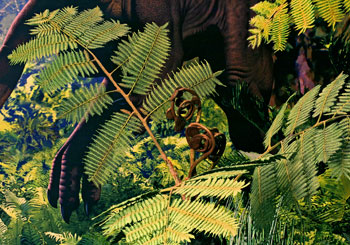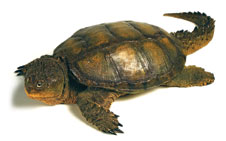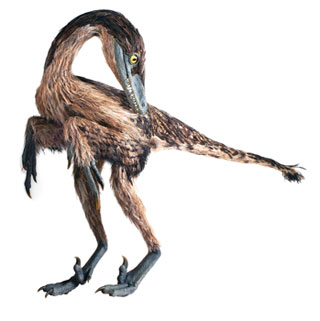Winter 2007
 |
||||||
Above: From the world’s first flowering plant to the most ferocious, now-extinct sea creatures, the Museum of Natural History’s new exhibit brings the Age of the Dinosaurs to life. Photos:Mindy McNaugher |
Tales from the Supporting Cast
Sure, dinosaurs take center stage in Dinosaurs in Their Time. But a supporting cast of hundreds—prehistoric plants, mammals, fishes, and strange-looking reptiles—combine to tell the whole story of life during the age of dinosaurs.Did dinosaurs walk the Earth alone? What did all those giant vegetarians eat, anyway? How much did Earth change over the roughly 165 million years that dinosaurs ruled over it? Did birds really evolve from dinosaurs? All good questions. And if you’re building the next big thing in dinosaur exhibits, why not answer them? Once they finally got the green light to create the dinosaur exhibit of their dreams, that’s just what the scientists at Carnegie Museum of Natural History figured they’d do. And they were in a pretty enviable position to do it, too. They had everything they needed: one of the world’s most massive collections of all kinds of fossils, not just dinosaurs. And they had their own ongoing discoveries about prehistoric life on Earth, which could not only inform the new exhibit but keep it current with the latest scientific findings. “This wasn’t a vanity project for us,” says Zhe-Xi Luo, associate director of research and collections at Carnegie Museum of Natural History, currently acting co-director of the museum, and one of the world’s most prolific researchers in the study of mammals from the Mesozoic Era, known as the Age of Dinosaurs. “This was always about creating something truly holistic in its approach to the study of dinosaurs and the world they lived in. “We really hope it will excite the public and inspire youngsters to explore their curiosity about the natural world and the world of science.” Dig This Turns out, a big inspiration for Dinosaurs in Their Time wasn’t big at all. It stood a couple inches tall, weighed about an ounce, and measured a mere six inches long. In the late ‘90s, a Carnegie Museum of Natural History team led by Luo found the fossil remains of a strange but wonderful mammal that, after careful study, told a new tale of what life was like for mammals in the Jurassic Period, 146-200 million years ago. “Luo’s discoveries of mammals from the Age of Dinosaurs really influenced our early thinking about what this exhibit would become,” says Matt Lamanna, assistant curator of vertebrate paleontology for the museum, who took over as lead scientific advisor on Dinosaurs in Their Time when he joined the museum in 2004. Luo and fellow Carnegie Museum scientist John Wible christened their find Fruitafossor (FROO-tah-FOOS-or), a name based on the town where the tiny bones were found—Fruita, Colorado—combined with “fossor,” the Latin word for “digger.” Seems this early mammal had mighty fore arms that it used to dig up its supper. Nicknamed “Popeye” because of those fore arms, it ranks as the most complete Jurassic-aged mammal ever found in North America.
“Its teeth show that it probably lived like an armadillo,” Luo explains. “It most likely used its massive arms and claws to dig in the earth to eat colonies of termites and other invertebrates. But it was also capable of eating plants when insects weren't available. This type of adaptation occurred many times in mammalian evolution, but this is its earliest known appearance. “Because of Fruitafossor, we now know that Mesozoic mammals were more specialized and diverse than we once thought,” Luo adds. “It’s that type of information that we think adds to the richness of Dinosaurs in Their Time.” Visitors to the exhibit will get to see the actual fossils or detailed casts of 10 mammals from the Jurassic and Cretaceous periods. And while the exhibit doesn’t feature the actual Fruitafossor fossil (the original, now being studied at the Natural History Museum of Los Angeles County, is too fragile to cast), astute passersby will spy its likeness painted in the massive Morrison Formation mural, poking its head out of some lush ground cover. Where the Flowers Didn’t Grow  “When you experience Dinosaurs in Their Time, you’ll see how dinosaurs changed over a long period of time,” Lamanna notes, “but at the same time, you’ll get to see how all life on Earth changed, as well.” “When you experience Dinosaurs in Their Time, you’ll see how dinosaurs changed over a long period of time,” Lamanna notes, “but at the same time, you’ll get to see how all life on Earth changed, as well.”Take plants, for instance. Prehistoric plant life is often difficult to study, since most rocks deposited during the Age of Dinosaurs haven’t yielded much in the way of plant fossils. “Most times all you’ll find at a site is a needle or a leaf,” says Paleobotanist Kirk Johnson, vice president of research and collections and chief curator of the Denver Museum of Nature and Science. “From that single needle or leaf, you have to figure out how big the tree or plant was; how big the branches or stems were, and what they might have looked like. And you can’t just look at a plant fossil and judge it against plant life we see around us today. Reconstructing a plant from the Mesozoic Era is always a challenge.” But like any good detectives, scientists use the best evidence they have to draw their conclusions. They know that ferns were among the most abundant types of plants for most of the three periods of the Age of Dinosaurs—the Triassic, Jurassic, and Cretaceous. Until the Cretaceous Period (66-146 million years ago), there were no flowering plants, including grasses, so some scientists surmise that prairies of ferns covered large, open spaces throughout most of the Age of Dinosaurs.
“Plants can tell you so much more about the environment they were found in than bones can,” explains Lyon. “From the shape of their leaves or needles you can tell what their climatic tolerance was. And you can interpret the landscape they lived in.” Based on the plant specimens found in the Morrison Formation—a swath of late-Jurassic rock that stretches from present-day Montana to New Mexico—Lyon says the region probably was on the sub-tropical and semi-arid side. Yet for all the plants in the three-dimensional displays and giant mural that wraps around two sides of the exhibit hall, not one dash of color other than green and brown is in sight. “There were no flowering plants, including grasses, during most of the Mesozoic Era,” says Lyon. “That includes fruit trees and grains.” When Phase Two of Dinosaurs in Their Time opens next spring, visitors will get to see replicas of some of Earth’s first flowering plants—of the above-ground kind, that is. For now, any hawk-eyed visitor to Dinosaurs in Their Time can see the genesis of the flowering plant as it’s been re-created in a lake margin in a section of the exhibit devoted to the early-Cretaceous environment of northeastern China. It’s a long-extinct, aquatic plant with tiny flowers, called Archaefructus (ahr-kee-FRUK-tus). “This is one of the first flowering plants we know of,” says Lamanna. “It was a sign that the world was changing. Human beings were still a long way off. But ecosystems around the planet were starting to become more modern.” Hell’s Aquarium Modern is a relative term, of course. Around the corner from Dinosaurs in Their Time’s Jurassic Atrium, the Cretaceous Seaway gives visitors a virtual dip into the most modern part of the current exhibit: a murky, mysterious world of huge sea turtles, enormous fishes, and toothy diving birds. And, yes, sea monsters. Representing a warm, shallow, inland seaway that once covered the current Midwestern United States and western Canada, the Seaway submerges visitors in a vanished marine world that existed about 85 million years ago.  “There was an incredible amount of life in that sea,” says Chris Beard, curator and head of the museum’s section of vertebrate paleontology. “Huge, 40-foot-long lizards that had adapted to an aquatic existence. Snake-necked reptiles with needle-sharp teeth and four powerful flippers. Animals like these are an inspiration for the Loch Ness Monster fable.” “There was an incredible amount of life in that sea,” says Chris Beard, curator and head of the museum’s section of vertebrate paleontology. “Huge, 40-foot-long lizards that had adapted to an aquatic existence. Snake-necked reptiles with needle-sharp teeth and four powerful flippers. Animals like these are an inspiration for the Loch Ness Monster fable.” Much like other areas of the Dinosaurs exhibit, the Cretaceous Seaway blends original fossil skeletons with precise cast replicas, including one of the Seaway’s largest predatory fish, Xiphactinus audax (zye-FAK-tin-us AWD-acks). Measuring between 12 and 15 feet long, it captured its prey with spike-like teeth. Less threatening but equally impressive is an extinct turtle, Protostega, that lived approximately 85 million years ago. Growing to 11 feet long, it was the second largest turtle that ever lived. Like modern sea turtles, females may have migrated hundreds of miles to lay their eggs on beaches, relying on their long front flippers and pointed heads to cut through waters on these treks. With a head nearly a yard long, Dolichorhynchops bonneri (DOL-ih-koh-RING-kops BONN-er-eye) was an underwater speed demon, even at l5 feet long and 13 feet from flipper to outstretched flipper. Its large powerful limbs provided considerable thrust and maneuverability. Yet, like its reptilian relatives and its underwater home, it had vanished from the planet by the end of the Mesozoic Era 66 million years ago.  Understanding how dinosaurs and other prehistoric life forms once thrived on Earth and why they ultimately died out carries important lessons for human beings today, says Luo. Understanding how dinosaurs and other prehistoric life forms once thrived on Earth and why they ultimately died out carries important lessons for human beings today, says Luo. “The dinosaurs didn’t make themselves go extinct,” he says. “They had no control over their fate. As scientists, we hope that Dinosaurs in Their Time will inspire people to discover more about the Earth’s history. So many animals other than the dinosaurs have disappeared. The same could happen to us—unless we take care of the planet.” |
|||||
Also in this issue:
Walking with the Dinosaurs · From Trophies to Treasures · The Popular Salon of the People: Then and Now · Director's Note · NewsWorthy · Now Showing · Face Time: Diplodocus carnegii · About Town: International Appeal · First Person: It takes a village to raise a dinosaur · Artistic License: Size Matters · Science & Nature: Bodies of Knowledge · Another Look: Neapolitan Presepio Celebrates
 |
Copyright © 2017 CARNEGIE Magazine. All rights reserved. |


